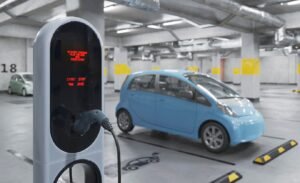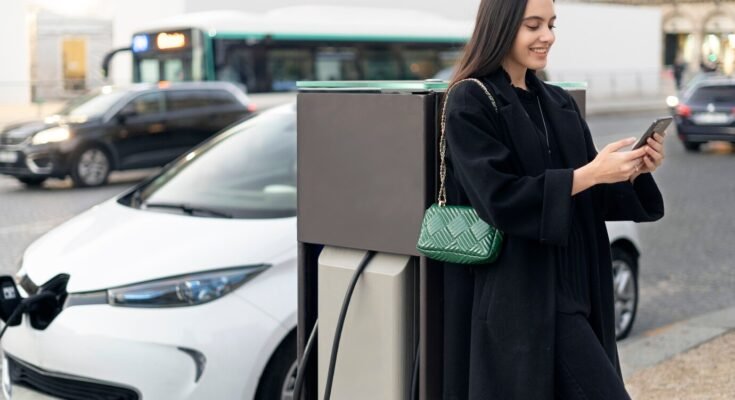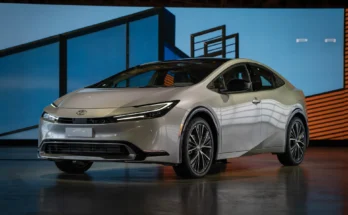Electric vehicle (EV) sales are growing rapidly across the globe. As governments push for greener transportation and consumers seek sustainable alternatives. The demand for EVs continues to rise. Advances in technology and increasing affordability are helping drive this shift.
So—-in the coming years, electric vehicles are expected to play a key role in reshaping the automotive industry.
What is The Projected Global Growth For Electric Vehicle Sales in 2024?
Electric vehicle (EV) sales are set to grow significantly in 2024. Sales of battery-electric vehicles and plug-in hybrids are expected to exceed 10 million units globally. This is a sharp increase from 2.1 million units in 2019. Experts predict that EVs will account for 62% of new car production worldwide by 2035.
This growth is driven by advancements in technology and increased consumer demand. The trend highlights a shift towards cleaner and more sustainable transportation.
How are Electric Vehicles Being Adopted in Car-sharing Services Across Europe?
Electric vehicles (EVs) are increasingly featured in carsharing fleets across Europe. In London, Zipcar is expanding its electric vehicle options and aims to achieve net zero emissions by 2050. ShareNow set a target in 2019 to include 26% of electric vehicles in its European fleet by the end of that year.
As of the latest reports, 20.5% of carsharing vehicles in Germany are electric. Italy sees over 25% of its carsharing fleet as electric. The UK has 14% of its carsharing vehicles powered by electricity. This adoption reflects a broader push towards cleaner mobility options across the continent.
What is The Current Percentage of Electric Vehicles in Carsharing Fleets in Various North American Cities?
North American cities are gradually increasing their electric vehicle (EV) presence in carsharing fleets. Zipcar has initiated a significant push to expand its EV fleet in major cities such as Boston, Chicago, New York City, San Francisco, Los Angeles, Portland, Seattle, Baltimore, Denver, and Philadelphia. Specific percentages vary, but the trend shows a clear movement toward incorporating more EVs. Zipcar plans to double its current EV fleet size by 2024, which reflects a growing commitment to electric mobility.
What are The Main Challenges Faced by car-sharing Operators in Integrating Electric Vehicles?
There are several challenges faced by car-sharing operators when integrating electric vehicles (EVs).
High upfront costs and maintenance expenses weigh heavily on operators. EVs cost more to purchase than traditional vehicles due to advanced technology and expensive batteries. Operators also face higher repair costs. EVs require less frequent service, repairs can be costly. Hertz’s recent sale of 20,000 EVs highlighted these challenges.
The prediction of residual values for electric vehicles is another challenge. Rapid advancements in technology can make older models obsolete quickly. Battery degradation also impacts value. Operators struggle to forecast long-term returns on EV investments. High costs of battery replacement add to this uncertainty. Consumers’ acceptance of remanufactured batteries remains unclear.
Infrastructure support for EVs lags behind the adoption push. Many governments aim to phase out fossil fuel vehicles, but charging networks often fail to keep pace. Operators sometimes need to invest in their charging infrastructure. The capacity of local electrical grids to handle widespread EV charging is also a concern. Upgrades and investments are necessary to support increased loads.
How do High Upfront Vehicle Costs and Maintenance Expenses Affect EV Adoption in Carsharing?
High upfront costs make EV adoption difficult for car-sharing operators. Electric vehicles cost more than traditional cars due to their advanced technology and battery systems. These costs impact the financial feasibility of carsharing companies, which already operate on tight margins.

Maintenance costs, although less frequent, also add strain. Repairs for EVs can be more expensive, especially when dealing with battery replacements. These factors create hesitation among operators, as they balance between sustainability goals and financial realities.
Government incentives and future cost reductions may help, but current barriers remain significant.
What Factors Contribute to The Uncertainty of Residual Values For Electric Vehicles?
Several factors make the residual value of electric vehicles uncertain. Rapid technological advancements often render older models less valuable. Newer, more efficient EVs quickly replace them in the market. Its battery health also plays a key role.
As batteries degrade over time, the vehicle’s range and performance decline, which reduces its resale value. High replacement costs for batteries add further uncertainty. Consumer trust in used EVs remains low, especially regarding remanufactured batteries. These factors make it hard for operators to predict long-term returns on their EV investments.
How does The Current Infrastructure For EV Charging impact car-sharing Operators?
Limited EV charging infrastructure creates major hurdles for car-sharing operators. Many regions lack sufficient charging stations. This makes it difficult for operators to expand their fleets. Operators often face the burden of investing in their charging infrastructure, especially in North America.
Electrical grids in many cities cannot handle the growing demand for EV charging. This puts additional pressure on operators who want to adopt EVs. Delays in charging network development slow down the push for more electric vehicles in carsharing services.
What Strategies Can Help Reduce The Costs of Electric Vehicles and Make Them More Affordable?
Electric vehicle costs can be reduced through several key strategies. Increased competition among manufacturers lowers prices as more EV models enter the market. Advances in battery technology also cut costs since batteries account for a large portion of an EV’s price.
Government incentives play a major role in making EVs more affordable for car-sharing operators. Mass production and design innovation help reduce upfront costs. More mechanic training specific to EVs can lower long-term maintenance expenses. It improves overall affordability.
How Might Advancements in Battery Technology Impact the Future of EVs in Carsharing?
Advancements in battery technology will transform the future of EVs in carsharing. New battery designs increase range, reducing the need for frequent charging and boosting vehicle availability. Solid-state batteries offer longer lifespans and quicker charging times.
It makes EVs more practical for shared fleets. Lighter batteries improve vehicle efficiency, which lowers energy costs for operators. These innovations also make EVs more reliable, which enhances user trust and satisfaction.
What Role Does The Standardization of EV Charging Infrastructure Play in Supporting Carsharing?
Standardization of EV charging infrastructure plays an important role in carsharing. Consistent charging systems allow for easier and faster access to power, which reduces downtime for vehicles.
It simplifies the user experience by providing uniform plug types and charging methods across regions. This also encourages more operators to expand EV fleets since compatibility issues decrease. Moreover, standardization ensures that charging stations remain widely accessible, which supports the growth of shared mobility services.
What Are The Potential Benefits and Obstacles of Integrating Electric Vehicles Into Carsharing fleets?
Electric vehicles offer clear advantages in carsharing fleets. They lower emissions, helping meet environmental goals. Fuel costs decrease, which makes operations more cost-effective. Customers appreciate cleaner, quieter rides, improving user experience.
High upfront costs and uncertain maintenance expenses create financial risks. Limited charging infrastructure complicates operations. Depreciation and battery life concerns affect long-term value. Besides these issues, the benefits push many operators to explore EV integration further.
How Can Car-sharing Companies Navigate The Challenges of Adopting Electric Vehicles?
It is challenging for car-sharing companies to adopt electric vehicles. Analyze total ownership costs to understand long-term expenses. Leverage government incentives to reduce high upfront costs. Train employees to handle EV maintenance effectively. It uses telematics to monitor vehicle health and manage depreciation.
Secure partnerships with charging infrastructure providers to ensure sufficient charging options. Refresh the fleet regularly to include the latest EV models, which enhances reliability and customer satisfaction.
Conclusion
It is both an opportunity and a challenge to integrate electric vehicles into carsharing fleets. High upfront costs and maintenance expenses can be significant hurdles. However, advancements in battery technology and standardization of charging infrastructure offer promising solutions.
Companies must navigate uncertainties in residual values and adapt to evolving market conditions. Strategic planning and leveraging incentives can help mitigate these challenges. Electric vehicles are environmentally friendly and make carsharing more appealing. So—urban mobility’s future depends on embracing these changes.


